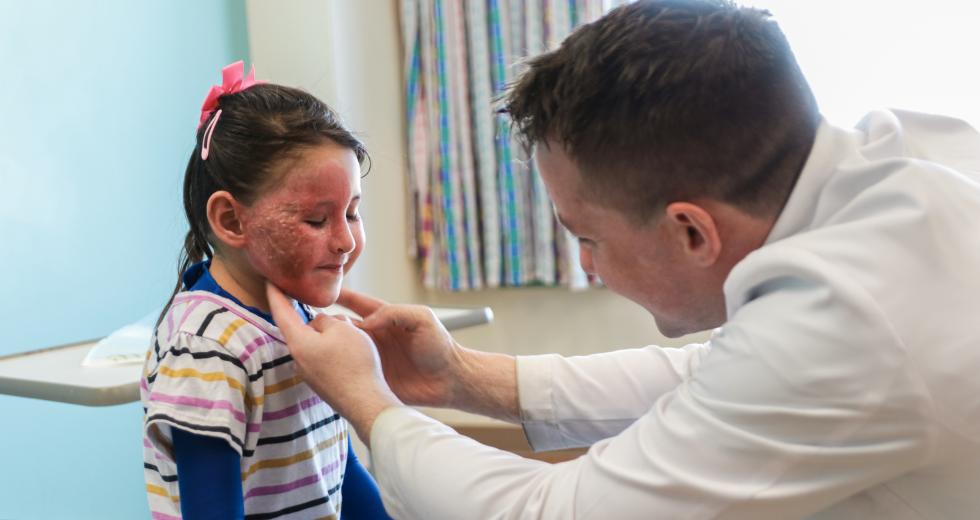Jason Heard recalls the day everything changed.
It was May 2, 2003. Living in Iowa, Heard was 12 years old, an unserious kid who liked to clown around. That day, he skipped school and was playing with fire with some friends in his dad’s backyard. Feeling invincible, Heard grabbed a can of gasoline from the garage to stoke the flames. Instead, a trickle of gas from the can ignited and created a huge explosion, engulfing him in fire. He was flown to a burn center in Iowa City, where he ended up on a ventilator with second- and third-degree burns over nearly 40 percent of his body, including his face, upper chest, both arms and a leg. After five weeks in the hospital and four weeks in a rehab facility, Heard returned home, determined to live the rest of his life as a normal kid. But, he says, “I looked very different.”
At 33, Dr. Jason Heard bears only faintly visible scars from the
accident that changed his life forever.
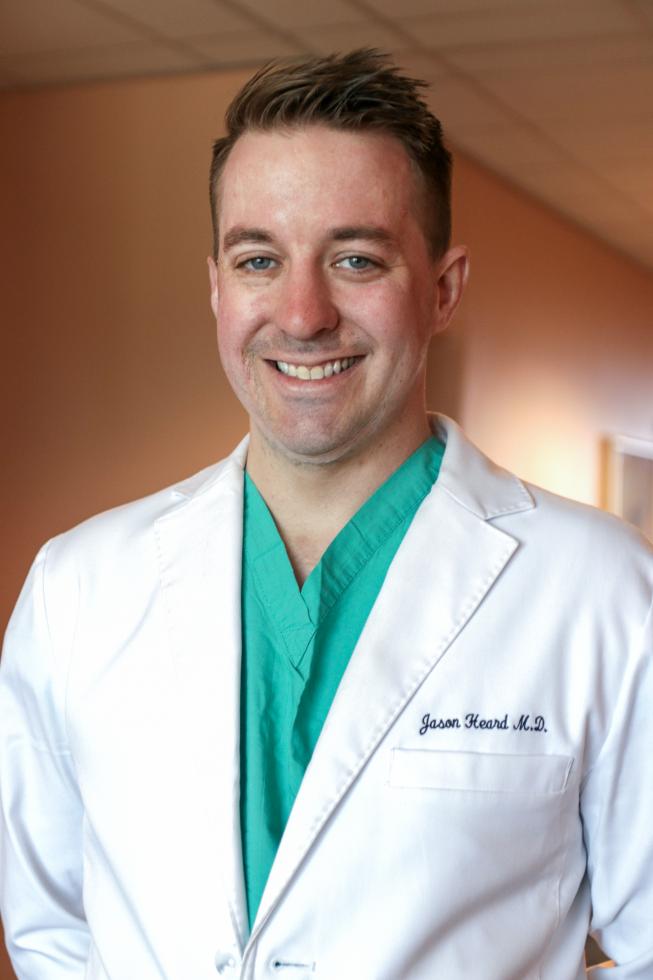
That accident, terrible though it was, set Heard on his life’s path. Today, he is a burn surgeon at Shriners Children’s in Sacramento, where he treats hundreds of children like himself who experience life-changing burns.
Heard suffered significant facial disfigurement and lost half of his right ear in the accident. During his first hospitalization, he underwent three skin-grafting surgeries. Over the ensuing years, he would require many more. One time, as a teen, he angrily tore up photos of himself. “I hated my life,” he says.
A family friend got him into the Shriners Children’s system, which is now an international health care system, operating 29 pediatric facilities in the United States — hospitals, clinics and ambulatory care centers — and hundreds of outreach locations around the globe. Shriners Children’s provides specialized care to children with orthopedic, neuromuscular, colorectal and gastrointestinal conditions, craniofacial conditions, spinal cord injuries and burn injuries — all at no cost to the children and their families. During his teens, Heard went to Shriners Children’s in Ohio numerous times for laser procedures and reconstructive surgeries, including one to reconstruct his right ear. Each time, Shriners Children’s paid for his travel and everything related to his treatment.
During this time, Heard decided to become a doctor, and he began taking school seriously. At 18, he went to the University of Iowa to study biology and genetics. There, he did research at the same burn unit where he had been treated, publishing his first research paper at the age of 19. He traveled to Zambia three times with a mentor to do research on burn care in developing countries.
Heard also met with young burn patients and their parents to share his story. The kids wanted to know what they would look like. The parents were filled with guilt and fear: Is my kid’s life over? Will they be able to have a job, get married, have children? Heard gave them hope, reassuring them that the kids could live a normal life.
After medical school at the University of Iowa, he applied for a residency at UC Davis Medical Center on the strength of its burn unit. After only a year, he went home to Iowa to care for his ailing father but promised to return to Sacramento. In 2021, he came back as a burn critical care fellow and was hired a year later as a burn surgeon. He works at both UC Davis’ Firefighters Burn Institute Regional Burn Center and at Shriners Children’s Neil Reitman Pediatric Burn Institute, which is widely recognized as one of the world’s leading pediatric burn care treatment and research programs. (The two hospitals share a campus in Sacramento’s Elmhurst neighborhood.)
Burn surgery is exacting work. For patients with third-degree burns, surgeons “take the burn off” under general anesthesia, using surgical tools to remove dead tissue down to the fat layer. These so-called “tangential excisions” are followed by grafting using either the patient’s own skin or a temporary substitute.
At some burn units, it can take a single surgeon several operations over several days to take the burn off a badly injured patient. At Shriners Children’s, as many as five surgeons operate on a single patient at one time. The teamwork is seamless, and the process takes just a few hours. “That’s why our outcomes are so good,” says Heard. The goal is to remove the burned tissue and cover the wounds with skin as quickly as possible. Reconstructive surgery will follow later.
At Shriners Children’s, Heard sees young patients from Northern
California, western Nevada and southern Oregon, as well as
children who can be referred from anywhere in the country.
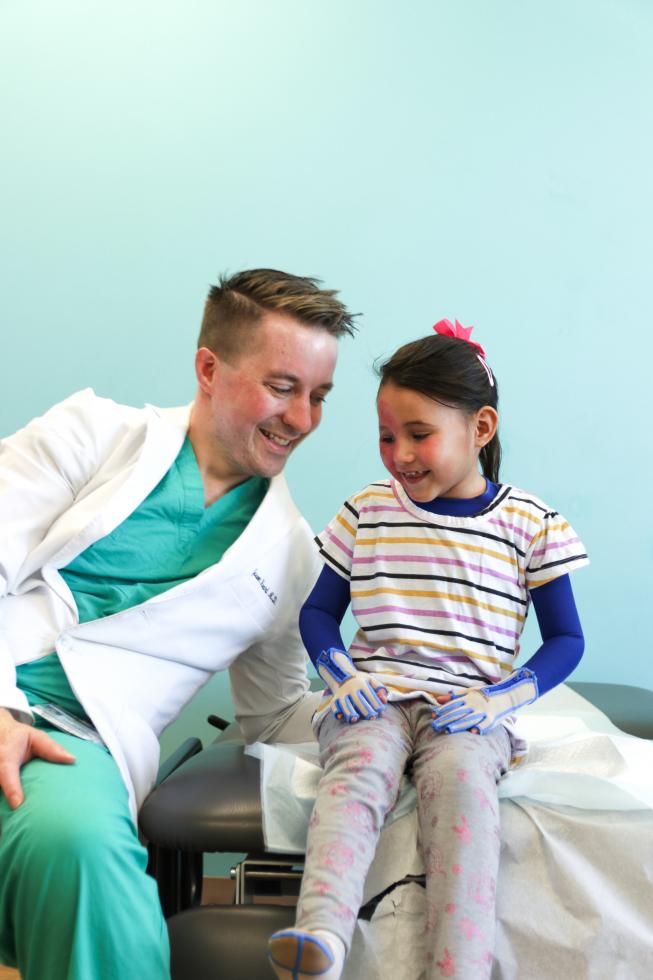
At Shriners Children’s, Heard sees young patients from Northern California, western Nevada and southern Oregon, as well as children who can be referred from anywhere in the country with “bad burns” (those affecting 50 percent or more of the body). Shriners Children’s also cares for badly burned children flown in from Mexico and holds outreach clinics in Mexico for kids who can’t come to the United States. In October, Heard saw 80 kids in a single day at a clinic in Tijuana.
Heard has a strong rapport with both his patients and their parents. “Parents have a ton of questions,” he says. “I get to know them and what they’re worried about.” Young patients who are struggling often get referred to him. “As both a burn survivor and a burn surgeon, I offer them hope and assurance and give them a picture of what life will be like.” For such children, meeting someone who was burned as a kid can be a powerful experience, he says. “It can really turn things around.”
Pediatric burn patients have different needs than adult patients. Their scars don’t grow along with their bodies, so they often need multiple reconstructive surgeries as they grow. Shriners Children’s provides ongoing treatment to patients until they are 21, then refers them to UC Davis for continuing care.
Heard works to spread burn awareness. The No. 1 cause of childhood burns is scalds, primarily caused when a child knocks over or pulls down a hot liquid like coffee or tea. A more surprising source of scalds, according to Heard: Cup Noodles. The innocuous childhood snack comes in a poorly designed container that is easily tipped over. Bathtubs are another common danger. A child left alone in the tub can accidently turn on the hot water faucet and be badly burned in just a few seconds.
Heard’s advice to parents: Keep hot things out of reach. Turn pot handles inward so children can’t grab them. Don’t turn your back on a child during bath time. And set your home’s hot water heater to 120 degrees. (At 140 degrees, the standard setting, a child will get a third-degree burn within five seconds; at 120 degrees, it takes five minutes to get a burn.)
Now 33, Heard recently got married. He and his husband, a dentist, hope to start a family soon. Today, he bears only faintly visible scars from the accident that changed his life forever. He credits burn doctors for saving his life and showing him the way to a fulfilling career and a full life.
National Burn Awareness Week 2024 is Feb. 4–10. This year’s campaign focuses on educating children and parents about the dangers of flammable liquids. You can find more information here. For more information about Shriners Children’s Neil Reitman Pediatric Burn Institute, visit their website.
Stay up to date on business in the Capital Region: Subscribe to the Comstock’s newsletter today.
Recommended For You

Startup of the Month: 3D Organic Polymer Silk
Trio of researchers aim to revolutionize orthopedic medicine with spider silk
With over 3 billion years of evolution under its belt, the natural world has a pretty long track record of creativity. Knowing this, three interdisciplinary researchers at UC Davis looked to the golden silk orb-weaver spider to develop an innovative biomaterial.

The Evolution of Aesthetics
Women and men have a variety of ways to look their best in the Capital Region
When it comes to “having a little work done,” it’s all about perception. “I was actually one of those people who thought they would never do Botox in their life,” says Shawna Chrisman, nurse practitioner and founder of Destination Aesthetics. “I just wanted to age gracefully.” But a product called Lattise — which she calls her “gateway” — changed her perspective on what that means.
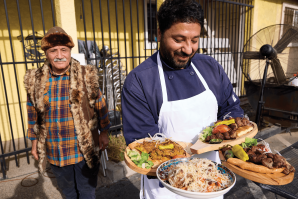
Photo Essay: Afghans Resettling in Sacramento
The Capital Region is home to more than 10,000 Afghan refugees who fled the Taliban. Comstock’s brings you a few of their stories.
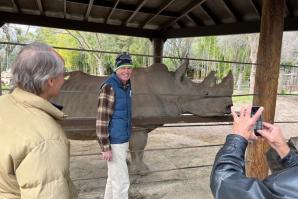
The Other J. Gregory
A late banker shares a name with a Sacramento Zoo rhinoceros. Coincidence?
Jan Gregory, a banker, passed away in May in Sacramento. Five days later, the front page of the Sacramento Bee announced that the Sacramento Zoo had acquired a rare white rhinoceros named J. Gregory.



